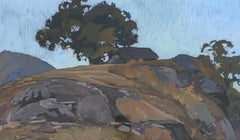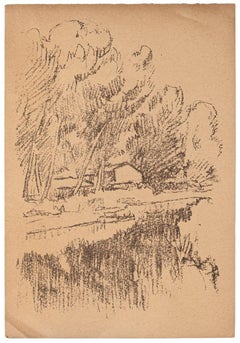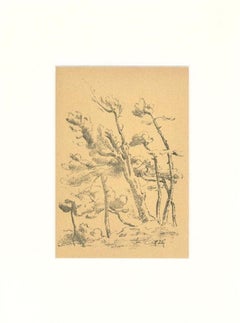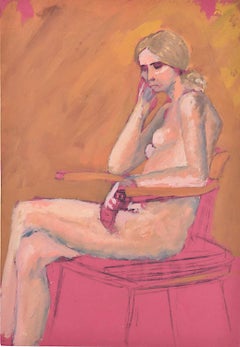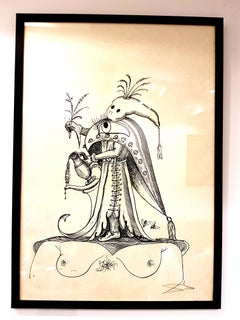Raffaele De Grada Art
Italian, 1885-1957
Initially trained by his father, a decorator, in Argentina and then from 1899 in Zurich, De Grada attended the academies of Dresden and Karlsruhe during the period 1902–05. Influenced by the Swiss secession movement, he enjoyed success as a landscape painter from 1913.
He moved to San Gimignano after World War I, then to Florence, where he lived until 1929. He joined the Novecento Italiano movement and participated in their two exhibitions in Milan (1926 and 1929) as well as their exhibitions collective in other Italian and European cities. His participation in the Venice Biennale began by invitation with the 13th Venice International Art Exhibition in 1922.
After moving to Milan in 1930, he obtained a professorship at the Monza School of Art in 1931. Particularly known for his beautiful views of the Tuscan countryside, De Grada welcomed different generations of artists into his home, including members of the Corrente movement, with whom he also exhibited works in the collective exhibition of the Society of Fine Arts and the Permanent Exhibition in 1939. He participated in numerous exhibitions after the Second World War.
Died in 1957.(Biography provided by Galerie Tonon)
to
5
5
3
1
1
1
1
Landscape in winter
By Raffaele De Grada
Located in Genève, GE
Work on canvas
Black wooden frame with gold borders
66.5 x 77 x 4.3 cm
Category
Early 20th Century Italian School Raffaele De Grada Art
Materials
Oil
Tuscany landscape
By Raffaele De Grada
Located in Genève, GE
Work on paper
Golden wooden frame with glass pane
57 x 79.5 x 4.5 cm
Category
Early 20th Century Modern Raffaele De Grada Art
Materials
Gouache
Landscape - Lithograph by Raffaele De Grada - Early 20th Century
By Raffaele De Grada
Located in Roma, IT
Landscape is an original lithograph realized by Raffaele De Grada.
The State of preservation is very good with very small folding along the margins.
Signe o...
Category
Early 20th Century Modern Raffaele De Grada Art
Materials
Lithograph
Landscape - Lithograph by Raffaele De Grada - 1946
By Raffaele De Grada
Located in Roma, IT
Landscape is an original lithograph realized in the 1946 by Raffaele De Grada.
The State of preservation is very good with very small folding along the margi...
Category
1940s Raffaele De Grada Art
Materials
Lithograph
Landscape - Woodcut by Raffaele De Grada - 1970s
By Raffaele De Grada
Located in Roma, IT
Landscape is an original woodcut realized in the 1970s by Raffaele De Grada
Signed on the lower right.
The State of preservation is very good.
Passepartout...
Category
1970s Raffaele De Grada Art
Materials
Woodcut
Related Items
Woman sitting: Hilary Hennes Miller c.1940 English Modern British Art
By Hilary Hennes
Located in London, GB
To see our other Modern British Art, including others by Hennes, scroll down to "More from this Seller" and below it click on "See all from this Seller" - or send us a message if you...
Category
1940s Modern Raffaele De Grada Art
Materials
Gouache
Salvador Dali - Les Songes Drolatiques - Handsigned Lithograph
By Salvador Dalí
Located in Collonge Bellerive, Geneve, CH
Hand-Signed Lithograph by Salvador Dali
Japan Paper
Title: Pantagruel's Dreams
Signed in Pencil by Salvador Dali
Dimensions: 76 x 56 cm
Edition: EA
1973
References : Field 73-7 (p. 1...
Category
1970s Surrealist Raffaele De Grada Art
Materials
Lithograph
Orange Grove Landscape
By Dorr Bothwell
Located in Los Angeles, CA
Orange Grove Landscape, 1941, gouache on illustration board, 14 inches x 18 inches (image), 22 x 26 inches (framed) signed and dated lower right, newly framed with museum glazing
...
Category
1940s American Modern Raffaele De Grada Art
Materials
Gouache, Board
Edo Landscape Japanese Woodblock Print
By Utagawa Hiroshige (Ando Hiroshige)
Located in Houston, TX
Edo Meisho woodblock print of a famous Japanese coastal dock. This woodblock is most likely apart of the series "One Hundred Famous Views of Edo." The woodblock print is printed on r...
Category
1850s Edo Raffaele De Grada Art
Materials
Woodcut
H 10 in W 15 in D 0.004 in
1950's French Impressionist Painting Cows Munching In Hay Field Landscape
Located in Cirencester, Gloucestershire
Cows Munching
by Y. Blanchon, French 1950's Impressionist artist
signed gouache on artist paper, unframed
painting: 12.5 x 16 inches
provenance: from a large private collection of th...
Category
Mid-20th Century Modern Raffaele De Grada Art
Materials
Gouache
Prodigal Son
By Thomas Hart Benton
Located in London, GB
A fine impression with full margins published by Associated American Artists with their information label present - pictured in Art and Popular Religion in Evangelical America, 1815-...
Category
1930s American Modern Raffaele De Grada Art
Materials
Lithograph
Salvador Dali (after) - New-York: Plaza (poster edition) - Lithograph
By (after) Salvador Dali
Located in Collonge Bellerive, Geneve, CH
Lithograph after an original watercolor by Salvador Dali
Title: New-York City : Plaza (pre-text/"avant la lettre" poster edition)
Printed Signature, da...
Category
1960s Surrealist Raffaele De Grada Art
Materials
Lithograph
H 19.69 in W 25.6 in D 0.04 in
Japanese Beauty Admiring Kirifuri Waterfall
By Yoshu Chikanobu
Located in Burbank, CA
A beauty turns to admire the Kirifuri Waterfall in Nikko Province. She holds the handle of an umbrella and wears fashionable clothing that is beautifully printed. This series pairs f...
Category
1890s Edo Raffaele De Grada Art
Materials
Mulberry Paper, Handmade Paper, Woodcut
Lithograph Italian Post Modernist Figurative Pop Art - "In The Beginning"
By Sandro Chia
Located in Surfside, FL
Sandro Chia (Italian, 1946)
Children Holiday, 1984
Lithograph in colors on six sheets of Somerset soft white,
71 x 77 inches (180.3 x 195.6 cm)
Numbered A.P. 13/15 (aside from an edi...
Category
Late 20th Century Pop Art Raffaele De Grada Art
Materials
Lithograph
Rare Chaim Gross Watercolor Painting Manhattan Skyscrapers Train NYC WPA Artist
By Chaim Gross
Located in Surfside, FL
This appears to be dated 1927. It came in with a piece dated 1929. A very early, rare work.
Framed 22.5 x 18. Image 14.5 x 9
A great New York city street scene with an El train (elevated subway line) and architectural renderings of buildings.
This is a wonderful piece by one of America's most treasured artists, Chaim Gross. Throughout his lifetime Gross has gone through tragedy and a real test of faith however, he has the unique ability to focus and direct his expression to the most joyful and beautiful works of art, such as the present lot. For more than sixty years Chaim Gross's art has expressed optimistic, affirming themes. His acrobats, cyclists, and mothers and children convey joyfulness, exuberance, love, and intimacy. This aspect of his work
remained consistent with his Hasidic heritage, which teaches that "only in his childlike happiness is man nearest to God." He often used his creative abilities to explore and experiment with media. In his artwork he retains an optimistic philosophy, even when facing somber issues such as war, depression, and the Holocaust.
Chaim Gross (March 17, 1904 – May 5, 1991) was an American sculptor and educator.
Gross was born to a Jewish family in Austrian Galicia, in the village of Wolowa (now known as Mezhgorye, Ukraine), in the Carpathian Mountains. In 1911, his family moved to Kolomyia (which was annexed into the Ukrainian USSR in 1939 and became part of newly independent Ukraine in 1991). When World War I ended, Gross and brother Avrom-Leib went to Budapest to join their older siblings Sarah and Pinkas. Gross applied to and was accepted by the art academy in Budapest and studied under the painter Béla Uitz, though within a year a new regime under Miklos Horthy took over and attempted to expel all Jews and foreigners from the country. After being deported from Hungary, Gross began art studies at the Kunstgewerbeschule in Vienna, Austria shortly before immigrating to the United States in 1921. Gross's studies continued in the United States at the Beaux-Arts Institute of Design, where he studied with Elie Nadelman and others, and at the Art Students League of New York, with Robert Laurent. He also attended the Educational Alliance Art School, studying under Abbo Ostrowsky, at the same time as Moses Soyer and Peter Blume.
In 1926 Gross began teaching at The Educational Alliance, and continued teaching there for the next 50 years. Louise Nevelson was among his students at the Alliance (in 1934), during the time she was transitioning from painting to sculpture. In the late 1920s and early 1930s he exhibited at the Salons of America exhibitions at the Anderson Galleries and, beginning in 1928, at the Whitney Studio Club. In 1929, Gross experimented with printmaking, and created an important group of 15 linocuts and lithographs of landscapes, New York City streets and parks, women in interiors, the circus, and vaudeville. The entire suite is now in the collection of the Philadelphia Museum of Art. Gross returned to the medium of printmaking in the 1960s, and produced approximately 200 works in the medium over the next two decades.
In March 1932 Gross had his first solo exhibition at Gallery 144 in New York City. For a short time they represented Gross, as well as his friends Milton Avery, Moses Soyer, Ahron Ben-Shmuel and others.
Gross was primarily a practitioner of the direct carving method, with the majority of his work being carved from wood. Other direct carvers in early 20th-century American art include William Zorach, Jose de Creeft, and Robert Laurent. Works by Chaim Gross can be found in major museums and private collections throughout the United States, with substantial holdings (27 sculptures) at the Hirshhorn Museum and Sculpture Garden. A key work from this era, now at the Smithsonian American Art Museum, is the 1932 birds-eye maple Acrobatic Performers, which is also only one and one quarter inch thick.
In 1933 Gross joined the government's PWAP (Public Works of Art Project), which transitioned into the WPA (Works Progress Administration), which Gross worked for later in the 1930s. Under these programs Gross taught and demonstrated art, made sculptures that were placed in schools and public colleges, made work for Federal buildings including the Federal Trade Commission Building, and for the France Overseas and Finnish Buildings at the 1939 New York World's Fair. Gross was also recognized during these years with a silver medal at the Exposition universelle de 1937 in Paris, and in 1942, with a purchase prize at the Metropolitan Museum of Art's "Artists for Victory" exhibition for his wood sculpture of famed circus performer Lillian Leitzel.
In 1949 Gross sketched Chaim Weizmann, President of Israel, at several functions in New York City where Weizmann was speaking, Gross completed the bust in bronze later that year. Gross returned to Israel for three months in 1951 (the second of many trips there in the postwar years) to paint a series of 40 watercolors of life in various cities. This series was exhibited at the Jewish Museum (Manhattan) in 1953.
In the 1950s Gross began to make more bronze sculptures alongside his wood and stone pieces, and in 1957 and 1959 he traveled to Rome to work with famed bronze foundries including the Nicci foundry. At the end of the decade Gross was working primarily in bronze which allowed him to create open forms, large-scale works and of course, multiple casts. Gross's large-scale bronze The Family, donated to New York City in 1991 in honor of Mayor Ed Koch, and installed at the Bleecker Street Park at 11th street, is now a fixture of Greenwich Village. In 1959, a survey of Gross's sculpture in wood, stone, and bronze was featured in the exhibit Four American Expressionists curated by Lloyd Goodrich at the Whitney Museum of American Art, with work by Abraham Rattner, Doris Caesar, and Karl Knaths. In 1976, a selection from Gross's important collection of historic African sculpture, formed since the late 1930s, was exhibited at the Worcester Art Museum in the show The Sculptor's Eye: The African Art Collection of Mr. and Mrs. Chaim Gross. Gross was elected into the National Academy of Design as an Associate member, and became a full Academician in 1981. In 1984, he was inducted into the American Academy of Arts and Letters, with Jacob Lawrence and Lukas Foss. In the fall of 1991, Allen Ginsberg gave an important tribute to Gross at the American Academy of Arts and Letters, which is published in their Proceedings. In 1994, Forum Gallery, which now represents the Chaim Gross estate, held a memorial exhibition featuring a sixty-year survey of Gross's work.
Gross was a professor of printmaking and sculpture at both the Educational Alliance and the New School for Social Research in New York City, as well as at the Brooklyn Museum Art School, the MoMA art school, the Art Student's League and the New Art School (which Gross ran briefly with Alexander Dobkin...
Category
Mid-20th Century American Modern Raffaele De Grada Art
Materials
Paper, Watercolor
Jonah
By Sadao Watanabe
Located in Santa Monica, CA
SADAO WATANABE (Japanese 1913-1996)
JONAH, 1959
Color stencil, signed, numbered and dated in white ink. Sheet, 25 5/8 x 22 5/8 inches. Edition: 44/50. Good color and generally good ...
Category
1950s Modern Raffaele De Grada Art
Materials
Stencil, Woodcut
"Various Himochi" Wagashi Festival Japanese Woodblock Print by Utagawa Toyokuni
Located in Soquel, CA
"Various Himochi" Wagashi Festival Japanese Woodblock Print by Utagawa Toyokuni
Rare oversized early 19th century 5-tiered woodblock by Utagawa Ichiyosai Toyokuni, (Japan, 1769-1825), a Japanese lord and wife oversee a sekku festival of food, music, and dolls or toys. '"oshi" is the first day of “Mi (Snake)” in the third month of the lunar calendar. This day, known in modern Japan as the Girls' Festival, originated in China as a form of purification ceremony in which water and drinking peach blossom wine were used to drive away evil. Many kinds of hishi-mochi appear in this picture of hina ningyo (dolls associated with Hinamatsuri, or the Girl’s Day) from Omochae.
The custom of eating special dishes at events throughout the year and at milestones in people's lives has existed since ancient times. This paragraph specifically focuses on the annual event called sekku, and life events that involve eating sweets. Joshi is the first day of “Mi (Snake)” in the third month of the lunar calendar. This day, known in modern Japan as the Girls' Festival, originated in China as a form of purification ceremony in which water and drinking peach blossom wine were used to drive away evil. According to the Keiso saijiki, in ancient China, on the third day of the third lunar month, people ate “ryuzetsuhan,” which is the juice of gogyo (Jersey cudweed) mixed with rice flour and nectar. In Japan, there is a record in the Heian period history book Nihon Montoku tenno jitsuroku [839-5] that it was an annual event to make kusamochi using gogyo on the third day of the third month of the lunar calendar, which may have been influenced by Chinese customs.
The tradition of eating kusamochi on the third day of the third month of the lunar calendar continued after that. By the Edo period, however, hishimochi had come to be used as a sweet to serve on the third day of the third month. A picture of a hishimochi is included in the Morisada manko , which we mentioned in Part 1. According to it, hishimochi in the Edo period were often three layers of green-white-green instead of the now common red-white-green. However, it is possible to see from our collection that not all hishimochi were made in this way. Omochae published in 1857, is a good example. Omochae is a type of ukiyoe print...
Category
1820s Edo Raffaele De Grada Art
Materials
Ink, Rice Paper, Woodcut
H 26.75 in W 21.75 in D 0.25 in
Raffaele De Grada art for sale on 1stDibs.
Find a wide variety of authentic Raffaele De Grada art available for sale on 1stDibs. If you’re browsing the collection of art to introduce a pop of color in a neutral corner of your living room or bedroom, you can find work that includes elements of orange and other colors. You can also browse by medium to find art by Raffaele De Grada in lithograph, gouache, paint and more. Much of the original work by this artist or collective was created during the 20th century and is mostly associated with the modern style. Not every interior allows for large Raffaele De Grada art, so small editions measuring 7 inches across are available. Raffaele De Grada art prices can differ depending upon medium, time period and other attributes. On 1stDibs, the price for these items starts at $223 and tops out at $1,931, while the average work can sell for $251.

